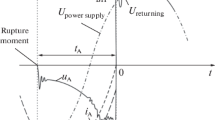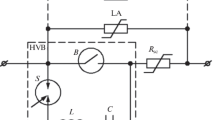Abstract
Current passing through electrical contacts causes additional heat release due to the presence of a contact resistance. Heat release in contacts may be considerable. In high-current contacts of high-voltage electrical equipment, the problem of overheating gets worse when fault short-circuit currents pass through the contacts. The maximum permissible level of these currents is limited by heating contact areas to their melting point. Welds due to melting of contacts lead to their failure as a rule. A way of considerably raising maximum permissible short-circuit currents has been suggested. Its idea is impulsive preheating of contacts to a temperature higher than the recrystallization temperature of the contact material. The efficiency of this approach has been confirmed experimentally. Numerical simulation of impulsive heating has been conducted. The results have helped us elaborate recommendations for selecting parameters of a train of current pulses that, acting on a contact, may greatly improve its stability against short-circuit currents.






Similar content being viewed by others
REFERENCES
GOST 52735–2007. Short-Circuits in Electrical Installations. Calculation Methods in Alternating Current Electrical Installations with Voltage above 1 kV (2007).
O. M. Pavleino, Candidate’s Dissertation in Engineering (St. Petersburg State Univ., St. Petersburg, 2015).
R. Holm, Electric Contacts (H. Geber, 1946).
P. G. Slade, Electrical Contacts: Principles and Applications (CRC Press, New York, 2013).
M. Braunovic, V. V. Konchits, and N. K. Myshkin, Electrical Contacts: Fundamentals, Applications and Technology (CRC Press, New York, 2006).
A. M. Chalyi, V. A. Dmitriev, M. A. Pavleino, and O. M. Pavleino, Surf. Eng. Appl. Electrochem. 49, 433 (2013).
O. M. Pavleino, M. A. Pavleino, and M. S. Safonov, in Proc. XI All-Russian Congress on Basic Problems of Theoretical and Applied Mechanics, Kazan, Russia, 2015, p. 2887.
Author information
Authors and Affiliations
Corresponding author
Additional information
Translated by V. Isaakyan
Rights and permissions
About this article
Cite this article
Chalyi, A.M., Dmitriev, V.A., Pavleino, M.A. et al. A Way of Increasing Maximum Permissible Short-Circuit Surge Currents in Electrical Contacts. Tech. Phys. 64, 569–574 (2019). https://doi.org/10.1134/S1063784219040078
Received:
Published:
Issue Date:
DOI: https://doi.org/10.1134/S1063784219040078




